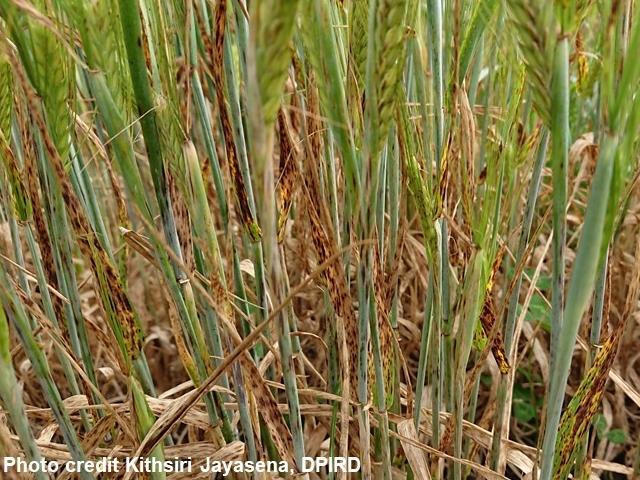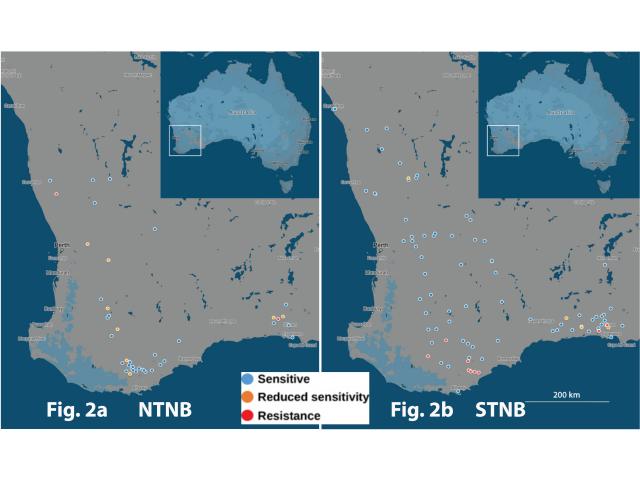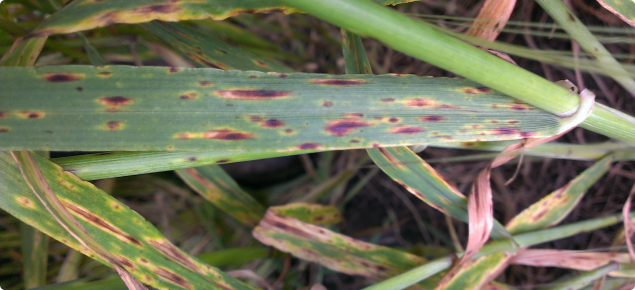Selecting a barley variety with a good resistance profile is the cheapest option in managing many foliar diseases such as net type net blotch (NTNB) and spot type net blotch (STNB). NTNB and STNB can cause considerable yield losses up to 35 per cent and 45 per cent respectively with reduced grain quality (increased screenings) which affects the receival for malting. The magnitude of yield loss depends on the resistance profile the varieties possess for these two diseases. In the absence of resistance, common practices in managing net blotches include crop rotation, stubble management (eg. burning), managing regrowth barley, maintaining good plant health and fungicides. Use of fungicides has become the most popular option among growers, particularly given the limited resistance profiles of some popular varieties especially to spot type net blotch. These can be viewed in the latest WA crop sowing guide.
Limited choices of fungicide chemistry and continued use of a few triazole based products has resulted in development of fungicide resistance among some net blotch pathogen populations. In 2015, a NTNB infected leaf sample from the Kojonup area was tested by researchers at Curtin University and triazole resistance was detected. Subsequently, STNB pathogen populations resistant to some triazole based products have also been detected in the Albany and Esperance Port Zones in 2017 (Figure 1).

Distribution of DMI resistance across the WA wheatbelt
At present DMI resistance (for actives such as prothioconazole, tebuconazole and epoxiconazole) is found in two populations of NTNB at Dandaragan (Geraldton Port Zone) and Scaddan (Esperance Port Zone) respectively (Figure 2a). In addition, NTNB pathogen populations with reduced sensitivity to DMI fungicides are found at eight locations across the wheatbelt, but most populations are still sensitive (Figure 2a).
The extent of the current distribution of DMI resistant net-type and spot-type net blotch populations across the wheatbelt is shown in Figure 2.

DMI resistance (for actives such as prothioconazole, tebuconazole and epoxiconazole) in STNB populations is more widely distributed compared to NTNB in the southern wheatbelt to south coastal parts of WA (Figure 2b). In addition, pathogen populations with reduced sensitivity to DMI actives are found in the Shires of Esperance and Dandaragan. Detection of “hybrid net blotch” (a mix between spot type and net type) which is highly resistant to DMI fungicides (Table 1) has made it important to adopt fungicide resistant management guidelines in WA.
| Pathogen | Resistance level | Location detected | ||
|---|---|---|---|---|
| NTNB | Moderate | Bakers Hill | Dandaragan | Beverley |
| West Arthur | Mt Barker | Tenterden | ||
| Scaddan | ||||
| Resistant | Scaddan | West Arthur | Dandaragan | |
| STNB | Moderate | Gibson | Coomalbidgup | Cascade |
| Resistant | South Stirling | Wellstead | Dalyup | |
| NTNB & STNB Hybrid | Resistant | Frankland | South Stirling | Amelup |
| Gibson | Dalyup | |||
Fungicide resistance management
At present, NTNB and STNB have only developed resistance to the DMI group of fungicides in WA. The DMI (DeMethylation Inhibitors) fungicides are a group of fungicides with the same mode of action that belong to FRAC code 3. Fungicides in two other groups (Qol- quinone outside inhibitors and SDHI-succinate dehydrogenase inhibitors) are also registered to manage both diseases in WA. The development of resistant net blotch pathogen populations to DMI fungicide is due to:
- growing susceptible barley varieties in close barley rotations; and
- continuous use of fungicides with same actives or from same group as seed dressings and following up with multiple foliar applications. For example using the same group of fungicide active for first spray from early post emergence with weed control, second at early stem extension and finally a third spray at the post flag leaf emergence growth stage in net blotch prone, long season environments.
The shift in the pathogen population from sensitive to reduced sensitivity and then to resistance has not happened overnight and has taken some time to be noticed in the field. Net blotch leaf sample testing for fungicide resistance shows that in most areas of the WA wheatbelt, fungicide sensitive populations of both net blotch pathogens exist. Therefore, action should be taken immediately to prevent further development of fungicide resistance in net blotch pathogen populations. We need to preserve the effectiveness of the fungicides that we have.
As a part of the fungicide resistance management strategy, fungicides need to be used as a last resort in conjunction with adopting Integrated Disease Management (IDM) principles.
- Use fungicide only if necessary
- Use fungicide mixtures with different active groups
- Use a maximum of two sprays per season from the same active group
- Alternate active ingredients or fungicide groups when applying more than one fungicide in a season
- Use either seed dressing or in-furrow fungicide (liquid or on fertiliser) coupled with no more than two fungicide mixtures as foliar applications
- Stick to registered label rates of the product
- When mixing different products (fungicide, herbicide, insecticide, liquid fertiliser and micro nutrients) read the labels for their compatibility.
Integrated disease management
- Use more resistant barley varieties whenever possible
- Choose paddocks where barley has not been grown for at least two years
- Manage stubble loads since net blotches are stubble borne
- Manage green bridge (self-sown barley)
- Avoid early sowing
- Provide adequate nutrition (avoid nitrogen deficiency, use adequate potassium)
What to do if fungicide resistance is suspected?
It is important to monitor the distribution of net blotches’ resistance to fungicides in the wheatbelt. If fungicide resistance is suspected net blotch leaf samples should be submitted to Curtin University for testing. Please contact the fungicide resistance team at frg@curtin.edu.au. Net blotch samples should be sent in a paper envelope addressed to Fran Lopez, CCDM, School of Molecular and Life Sciences, Curtin University, GPO Box U1987, Perth, WA 6845.
Fungicide choice
Selection of fungicides should match the management of disease threat/s present (according to label recommendations) while limiting the risk of development of fungicide resistance.
Registered fungicide products for seed dressing and in-furrow fungicides for barley and foliar fungicides are available via the following DPIRD web pages. Click on the titles below.
Seed dressing and in-furrow fungicides registered for cereal crops in WA
Registered foliar fungicides for cereal crops in WA
Caution note:
Succinate dehydrogenase inhibitor (SDHI) based actives such as fluxapyroxad (Systiva®) are registered as seed dressings against many barley diseases such as powdery mildew, net-blotches, scald, leaf rust, smuts and rhizoctonia. Like other fungicides, SDHI based products are also vulnerable to resistance development by the net blotch pathogen, this has recently occurred in York Peninsula, South Australia. If SDHI products are chosen as a seed dressing or foliar fungicide, they should be used wisely and in rotation with other fungicide groups, as part of an integrated management package to prevent resistance development.

